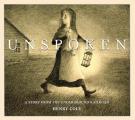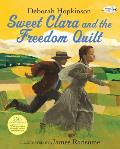Quandaries of Proofs and Historical Proof
Roger Sutton of The Horn Book just wrote about Unspoken, by Henry Cole, a picture book clearly designed around the myth of quilt patterns as guides on the Underground Railroad. The magazine was all set to publish a mixed review of the book, praising its art and storytelling but criticizing the perpetuation of a myth. But, just in time, the publisher changed the book’s afterword to remove all references to the myth.
Since the body of the book is wordless, there was no main text to change. The quilt remains a significant visual element, however. Sutton thinks the story remains “terrific and intriguing,” but he can’t help noticing that quilt hanging there.
By coincidence, this week I sent The Horn Book my review of an upcoming picture book about an event during the Revolutionary War, also generally praising its storytelling but pointing out a significant historical error. That error didn’t originate with the author-illustrator; it’s an all-too-common exaggeration of the event. The mistaken line could be removed without greatly affecting the larger story—but with the book already in proofs, it’s probably too late.
Sutton’s posting notes that Deborah Hopkinson and James Ransome’s picture book Sweet Clara and the Freedom Quilt linked quilt patterns and escaping from slavery in 1993. That was a story about a girl improvising a patchwork quilt to serve escapees as a map. The “quilt code” myth goes further, positing a widely known, prearranged, and yet secret code based on patchwork patterns, some not documented until after the U.S. Civil War.
Leigh Fellner, one of the quilt scholars working to disabuse of this myth, found the earliest manifestation of the quilt code myth to be a “brief statement in a 1987 feminist video” with no supporting citation. Sweet Clara… followed, probably independently and probably doing more to promote the linkage of quilts and escape routes.
After that picture book, a woman in Charleston, South Carolina, named Ozella McDaniel Williams told a similar story to Jacqueline Tobin while selling her quilts. After three years of fruitless searching for confirmation, Tobin went back to Williams and interviewed her at greater length. Based on that one source, Tobin wrote Hidden in Plain View with Raymond Dobard, Jr. One Oprah appearance later, and a new American myth was born.
Since the body of the book is wordless, there was no main text to change. The quilt remains a significant visual element, however. Sutton thinks the story remains “terrific and intriguing,” but he can’t help noticing that quilt hanging there.
By coincidence, this week I sent The Horn Book my review of an upcoming picture book about an event during the Revolutionary War, also generally praising its storytelling but pointing out a significant historical error. That error didn’t originate with the author-illustrator; it’s an all-too-common exaggeration of the event. The mistaken line could be removed without greatly affecting the larger story—but with the book already in proofs, it’s probably too late.
Sutton’s posting notes that Deborah Hopkinson and James Ransome’s picture book Sweet Clara and the Freedom Quilt linked quilt patterns and escaping from slavery in 1993. That was a story about a girl improvising a patchwork quilt to serve escapees as a map. The “quilt code” myth goes further, positing a widely known, prearranged, and yet secret code based on patchwork patterns, some not documented until after the U.S. Civil War.
Leigh Fellner, one of the quilt scholars working to disabuse of this myth, found the earliest manifestation of the quilt code myth to be a “brief statement in a 1987 feminist video” with no supporting citation. Sweet Clara… followed, probably independently and probably doing more to promote the linkage of quilts and escape routes.
After that picture book, a woman in Charleston, South Carolina, named Ozella McDaniel Williams told a similar story to Jacqueline Tobin while selling her quilts. After three years of fruitless searching for confirmation, Tobin went back to Williams and interviewed her at greater length. Based on that one source, Tobin wrote Hidden in Plain View with Raymond Dobard, Jr. One Oprah appearance later, and a new American myth was born.




No comments:
Post a Comment